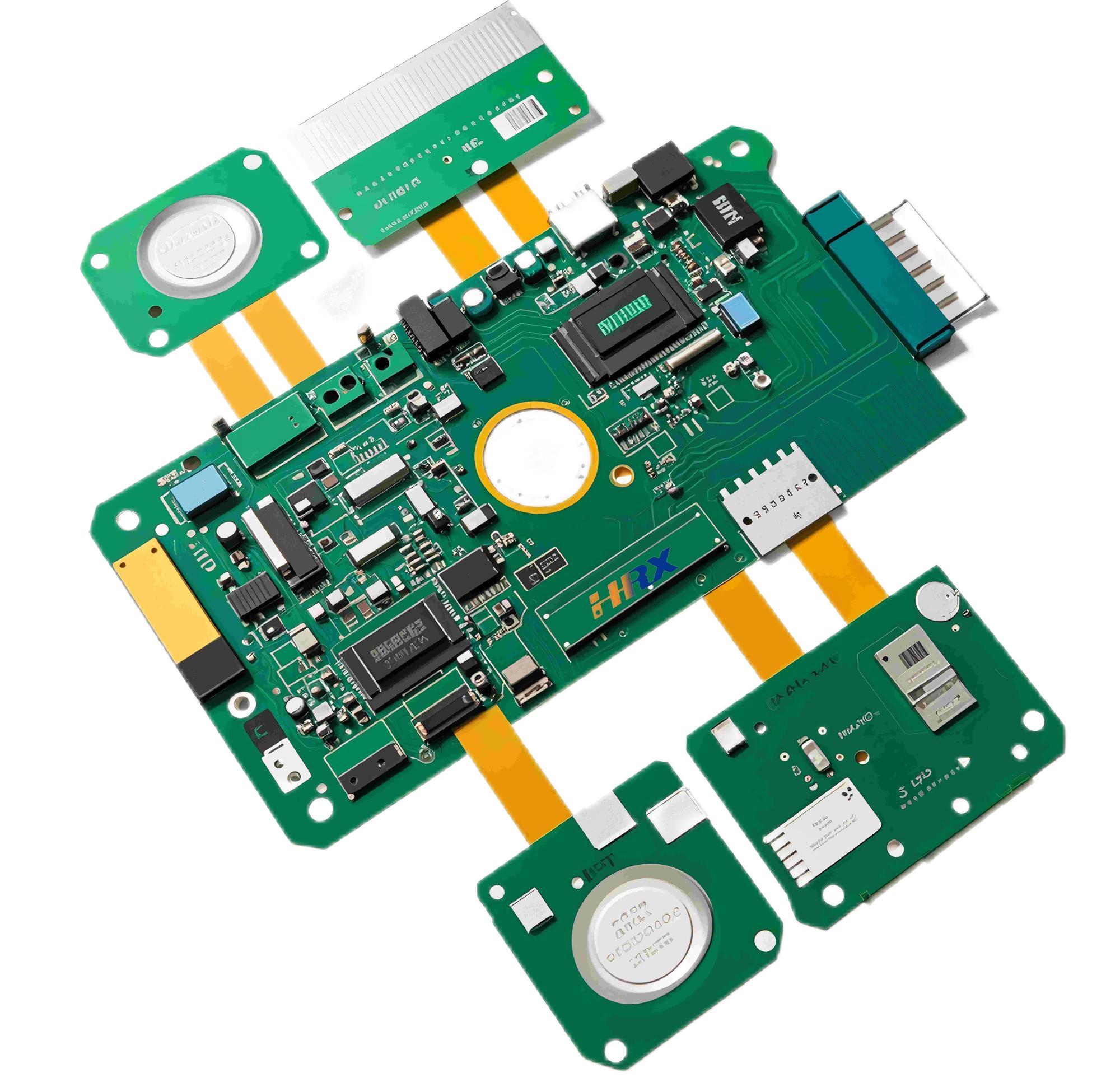Search
Precautions and Technical Management in the Design and Production of High-Precision Rigid-Flex Printed Boards
- Feb 27,2025
-
Share
In the rapidly evolving landscape of modern electronics, high-precision Rigid-Flex Printed Circuit Boards (RFPCBs) have emerged as a critical enabler for the miniaturization, high performance, and reliability of electronic devices. Designers hold a pivotal role in this domain, as the success of any electronic product often hinges on the meticulous design and production of these intricate boards. Spanning from portable consumer electronics to advanced aerospace and medical devices, RFPCBs are central to innovation by integrating the advantages of both rigid and flexible circuit technologies. For designers, understanding the subtleties of RFPCB design and production is not merely a professional requirement but also a key to unlocking the potential of next-generation electronics. This article will provide an in-depth examination of essential details, from design considerations to production processes, and explore how technical expertise management and innovation can drive the creation of high-quality RFPCBs.

I. Design Considerations
A. Layer Stack - up Design
Material Selection: In the realm of high - precision Rigid - Flex Printed Boards (RFPCBs), meticulous material selection is of paramount importance. Polyimide (PI) stands as a prevalent choice for flexible layers, attributed to its outstanding thermal stability and flexibility. For the rigid layers, FR - 4 materials, renowned for their high dimensional stability, are often employed. It is imperative to ensure the harmonious matching of the Coefficient of Thermal Expansion (CTE) among different materials. This precaution mitigates the risks of warping and delamination during thermal cycling, which are critical concerns in maintaining the long - term reliability of the RFPCB.
Layer Arrangement: Rational arrangement of signal layers and power layers is a fundamental aspect of RFPCB design. Keeping power planes in close proximity to signal layers is an effective strategy to curtail signal interference. In the context of high - speed signals, it is essential to establish a controlled - impedance environment for signal lines. For high - speed serial interfaces such as USB 3.0 or Ethernet, maintaining a characteristic impedance of 50Ω or 100Ω respectively is crucial to ensure signal integrity and minimize signal attenuation and distortion.
B. Trace Routing
Minimum Trace Width and Spacing: Determining the minimum trace width and spacing requires a comprehensive consideration of current - carrying capacity and electrical performance requirements. In high - precision RFPCB designs, the minimum trace width can be scaled down to as narrow as 3 - 5 mils, and the minimum spacing can be reduced to 3 - 4 mils. However, it is essential to take into account the manufacturing capabilities of the production facility. Factors such as the resolution of the photolithography process and the etching accuracy need to be considered to guarantee the manufacturability of the design.
Avoidance of Sharp Corners: Employing rounded or 45 - degree angles for trace routing instead of sharp corners is a well - established practice. Sharp corners can induce signal reflection due to the sudden change in impedance and cause the concentration of electric fields, both of which can have a detrimental impact on signal integrity. This can lead to signal degradation, increased bit - error rates, and overall system malfunctions.
II. Production Process Details
A. Lamination Process
Temperature and Pressure Control: During the lamination process of rigid and flexible layers in RFPCB manufacturing, precise control of temperature and pressure is indispensable. For PI - based flexible materials, the lamination temperature typically ranges around 350 - 400°C, and the pressure is maintained at approximately 30 - 50 psi. Deviations from these optimal parameters can result in poor adhesion between layers, compromising the mechanical integrity and electrical performance of the RFPCB.
Alignment Accuracy: Achieving high - precision alignment of rigid and flexible layers is a critical factor in ensuring the proper functionality of RFPCBs. Advanced alignment technologies, such as laser - based alignment systems, are commonly utilized to achieve an alignment accuracy within ±50μm. Precise alignment is essential for accurate via connections and the overall structural integrity of the board.
B. Drilling and Plating
Micro - Drilling: In high - density RFPCBs, micro - drilling technology is a prerequisite for establishing reliable via connections. The diameter of micro - vias can be as small as 0.1 - 0.2mm. Specialized drilling equipment, equipped with high - speed drills and advanced spindle technology, is employed to ensure the quality of drilled holes. The quality of micro - vias, including their roundness, wall smoothness, and absence of burrs, is crucial for optimal electrical conductivity.
Electroplating Thickness: Accurate control of the electroplating thickness of vias is essential for ensuring good electrical conductivity. The copper thickness of inner - layer vias should be carefully regulated to meet the requirements of current - carrying capacity and signal transmission. For example, the copper thickness of inner - layer vias can be maintained within the range of 15 - 30μm to ensure reliable electrical connections.
III. Technical Experience Management and Innovation
A. Experience Management
Database Establishment: Building a comprehensive database of past design and production cases is a strategic approach to leveraging technical experience. This database should record detailed design parameters, production process parameters, and the issues encountered along with their corresponding solutions. For instance, in the event of soldering issues arising from a particular design, the database should document the design details, the production process conditions at that time, and the corrective actions implemented. This historical data serves as an invaluable resource for future projects, enabling engineers to draw on past experiences and avoid repeating mistakes.
Process Standardization: Developing and refining production process standards based on accumulated experience is a cornerstone of quality control. Standardizing each process step, from the initial design review to the final product inspection, ensures the consistency and quality of RFPCBs. Process standardization also facilitates the training of new employees and improves overall production efficiency.
B. Innovation
New Material Application: Exploring the application of novel materials represents a frontier of innovation in the RFPCB industry. New types of flexible substrates with lower CTE or enhanced heat resistance are being investigated. For example, some advanced materials can endure higher operating temperatures, making them ideal for applications in high - temperature environments such as aerospace and automotive electronics.
Process Optimization: Continuous process optimization is a key driver of improving production efficiency and product quality. For example, adopting additive - manufacturing - based processes for forming vias can enhance the aspect ratio of vias and significantly reduce the production cycle. This innovative approach not only improves the manufacturing process but also enables the production of more complex and high - performance RFPCBs.

Shenzhen Huaruixin Electronics Co., Ltd. is a professional manufacturer specializing in the design and production of FPC (Flexible Printed Circuit), PCB (Printed Circuit Board), and Rigid - Flex Printed Boards. We cordially welcome new and old friends in the industry to engage in communication and mutual learning, aiming to jointly promote the development of the printed circuit board technology.

Let’s talk! We’ll provide the perfect solution for you!
-
 Huaruixin Electronics mainly produces printed circuit boards as the core business, to provide customers with one-stop solutions for FPC/PCB production, components sourcing and Assembly.
Huaruixin Electronics mainly produces printed circuit boards as the core business, to provide customers with one-stop solutions for FPC/PCB production, components sourcing and Assembly. - WHAT WE DO — PCB Design Solutions — Flex PCB Production — Components Sourcing — FPC&PCB Assembly
- PRODUCTS — Single Sided Flexible Circuits — Double Sided Flexible Circuits — Multilayer Flexible Cirucits — Rigid-Flex Circuits — FPC Assembly — PCB Assembly
- CAPABILITY — FPC Capability — Rigid-Flex Capability — PCB Capability — Assembly Capability
- Copyright © 2024 Shenzhen Huaruixin Electronics Co., Ltd. All Rights Reserved.
- Design By BONTOP


